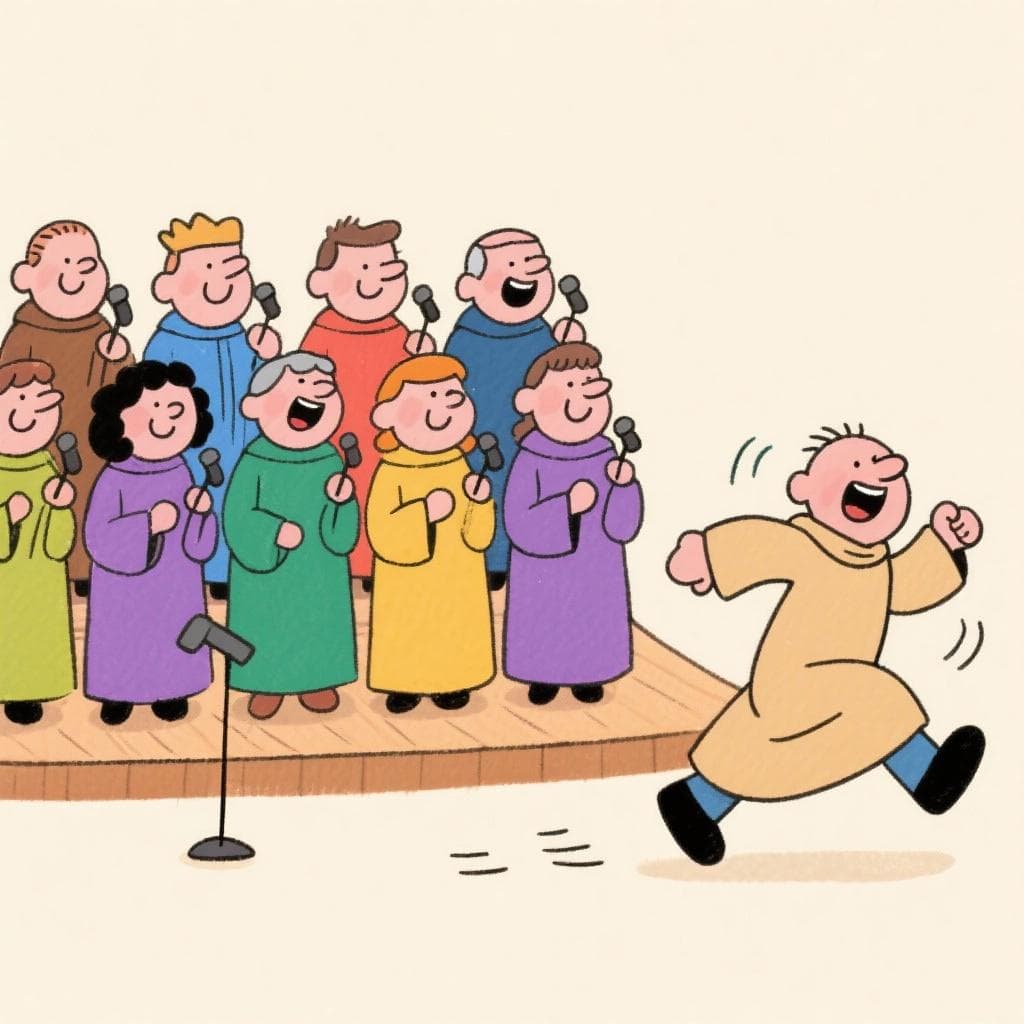Coro canta, corre, coro.
CO-ro CAN-ta, CO-rre, CO-ro
A choir sings, runs, a choir.
🔊 Listen & Practice
Start with slow speed to master pronunciation, then gradually increase to challenge yourself.
🎨 Visualization

A singing choir, a running choir! Can you say it without mixing up your 'r' sounds?
🎯 Pronunciation Focus
The Soft 'r' (Tap 'r')
/ɾ/The 'r' in 'coro' is a single, quick tap of the tip of your tongue against the roof of your mouth, right behind your front teeth. It sounds a lot like the 'dd' in the American English word 'ladder'.
The Rolled 'rr'
/r/The 'rr' in 'corre' is the famous trill. You create this sound by letting the tip of your tongue vibrate against the roof of your mouth. It requires relaxing your tongue and pushing air through.
Switching Between /ɾ/ and /r/
/ɾ/ vs /r/The main challenge here is muscle memory. This exercise trains your tongue to instantly switch from the light tap of 'coro' to the strong roll of 'corre' and back again.
📝 Practice Breakdown
Start with the soft 'r'. It's a single, light tap. Think 'co-do' but make the 'd' sound even faster and lighter with the tip of your tongue.
Now, engage the roll. Let the tip of your tongue relax and vibrate with your breath. If you can't roll it yet, just make the sound longer and stronger than the 'r' in 'coro' as a starting point.
This is the transition. Feel the difference between the vibrating 'rr' and the quick tap 'r'. The goal is to make them sound clearly distinct.
Key Words in This Tongue Twister:
📚 Background
This isn't a storytelling tongue twister; it's a pure pronunciation drill. It's one of the most fundamental exercises for Spanish learners to master the critical difference between the single 'r' (tap) and the double 'rr' (roll), a distinction that can change a word's meaning entirely.
❌ Common Pitfalls
Using the Same 'r' for Both
Mistake: "Pronouncing 'coro' and 'corre' with the identical 'r' sound, either by rolling both or tapping both."
Correction: Focus on the contrast. The 'r' in 'coro' is a light tap. The 'rr' in 'corre' is a sustained vibration. Think of them as two completely different sounds. A great example is 'pero' (but) vs. 'perro' (dog).
Using the English 'r'
Mistake: "Making the 'r' sound in the back of the mouth or with the middle of the tongue, like the 'r' in the English word 'core'."
Correction: Both Spanish 'r' sounds happen at the very front of your mouth. The action is all with the tip of your tongue tapping or vibrating against the ridge behind your top teeth.
🌎 Where It's Used
General Spanish
This is a universal pronunciation exercise used across the entire Spanish-speaking world to teach the difference between the 'vibrante simple' (/ɾ/) and the 'vibrante múltiple' (/r/).
🔗 Related Tongue Twisters
The R vs. RR Relay
Say it five times in a row, getting a little faster each time. Your goal is to make the 'r' in 'coro' and the 'rr' in 'corre' sound clearly different every single time.
🏷️ Tags
Frequently Asked Questions
Why is the difference between 'r' and 'rr' so important in Spanish?
It can completely change the meaning of a word! For example, 'pero' means 'but', while 'perro' means 'dog'. Similarly, 'caro' means 'expensive', but 'carro' means 'car'. Mastering this one sound difference unlocks a new level of clarity in your Spanish.
I really can't roll my 'rr'. Is it hopeless?
Not at all! It's a physical skill, like learning to whistle. Many people struggle with it. Keep practicing drills like this one. Try holding the 'tr' sound in 'tres' and you'll feel the start of the vibration. Be patient with yourself; your mouth is learning a new trick!


